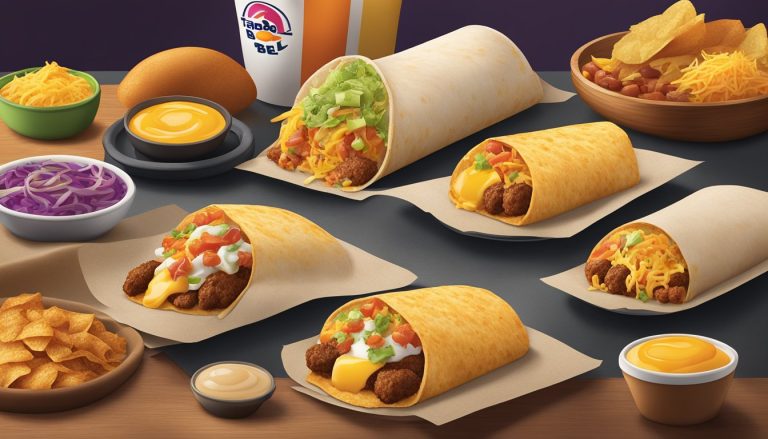Taco Bell’s breakfast menu has become a popular choice for morning diners seeking a unique twist on traditional breakfast fare. Behind the scenes, a complex supply chain ensures that fresh ingredients are delivered to thousands of locations daily. Taco Bell’s breakfast supply chain involves sourcing, processing, and distributing a variety of components including eggs, cheese, meats, and tortillas to create their signature morning offerings.
The fast-food giant’s breakfast supply chain is designed for efficiency and flexibility. It allows Taco Bell to maintain consistency across its locations while adapting to regional preferences and seasonal changes. This intricate network of suppliers, distributors, and logistics partners works in tandem to keep breakfast items stocked and ready for early morning customers.
Quality control plays a crucial role in Taco Bell’s breakfast ingredient supply chain. The company implements strict standards to ensure that all components meet their specifications for taste, freshness, and safety. From farm to restaurant, each step of the process is carefully monitored to maintain the integrity of the ingredients that make up Taco Bell’s breakfast menu items.
Taco Bell’s Place in the Fast-Food Industry

Taco Bell has established itself as a major player in the fast-food industry, known for its Mexican-inspired menu and innovative offerings. The chain’s strategic focus on market research, customer preferences, and breakfast market expansion has solidified its position among top competitors.
Market Research and Customer Preferences
Taco Bell’s success stems from its keen understanding of consumer tastes. The chain regularly conducts market research to stay attuned to evolving preferences. This data-driven approach allows Taco Bell to tailor its menu and marketing strategies effectively.
The company’s ability to cater to 40 million customers weekly across 7,200+ U.S. locations demonstrates its strong market presence. Taco Bell’s affordable pricing and flavorful offerings have cultivated a loyal customer base.
To maintain its competitive edge, Taco Bell continuously refines its menu based on customer feedback. This responsiveness has helped the chain adapt to changing dietary trends and cultural influences.
Innovation and Breakfast Market Strategies
Taco Bell’s foray into the breakfast market showcases its innovative spirit. The chain has differentiated itself by offering unique Mexican-inspired breakfast items, setting it apart from traditional fast-food breakfast menus.
Innovation extends beyond menu items to include:
- Digital ordering systems
- Mobile app development
- Drive-thru efficiency improvements
These technological advancements enhance customer experience and streamline operations. Taco Bell’s commitment to innovation has allowed it to capture a significant share of the growing breakfast market.
The chain’s breakfast strategy focuses on convenience and bold flavors. By leveraging its existing supply chain and kitchen equipment, Taco Bell has efficiently integrated breakfast offerings without major operational overhauls.
Taco Bell’s successful breakfast expansion has increased its market share and revenue streams, further solidifying its position in the competitive fast-food landscape.
Sourcing Breakfast Ingredients

Taco Bell’s breakfast menu relies on a complex supply chain to deliver fresh, quality ingredients to customers each morning. The company emphasizes quality control and efficient sourcing strategies to ensure consistent product offerings across its locations.
Ensuring Quality Ingredients
Taco Bell partners with trusted suppliers to source high-quality breakfast ingredients. The company prioritizes freshness and nutritional value in its selection process. Eggs come from certified farms that meet strict animal welfare standards. Cheese suppliers undergo regular audits to maintain product consistency.
Produce like tomatoes and lettuce are sourced from regional farms when possible to reduce transportation time. Coffee beans are carefully selected from sustainable sources and roasted to Taco Bell’s specifications. The company works closely with suppliers to develop custom blends that complement its breakfast menu items.
Quality control measures are implemented at every stage of the supply chain. This includes regular inspections, testing protocols, and temperature monitoring during transit.
Outsourcing Meat Cooking and Preparation
Taco Bell outsources the cooking and preparation of many meat products used in its breakfast items. This strategy allows for consistency across locations and reduces the workload on individual restaurants. Sausage patties and bacon strips are pre-cooked at specialized facilities.
These facilities use industrial-scale equipment to ensure uniform cooking and optimal food safety. The meat is then quickly frozen to lock in flavor and freshness. Taco Bell’s distribution network transports these prepared meats to restaurants nationwide.
At the restaurant level, staff simply need to reheat and assemble the pre-cooked meats into breakfast items. This streamlined process helps maintain product quality and reduces preparation time during busy morning hours.
Menu Development and Marketing

Taco Bell’s foray into breakfast involved careful menu planning and targeted marketing efforts. The company focused on creating unique breakfast options that aligned with their brand while implementing promotional strategies to attract customers during morning hours.
Designing Breakfast Options
Taco Bell developed a breakfast menu that blended familiar morning flavors with their signature Mexican-inspired cuisine. Key items included the Waffle Taco, Breakfast Crunchwrap, and various breakfast burritos. These offerings emphasized portability and customization to cater to on-the-go consumers.
The company prioritized ingredients that could be easily integrated into their existing supply chain. This approach helped minimize additional costs and streamline kitchen operations. Taco Bell also considered regional tastes and preferences when crafting their breakfast lineup.
Promotions and Marketing Strategies
To introduce their breakfast menu, Taco Bell launched aggressive marketing campaigns. These efforts included social media blitzes, television commercials, and in-store promotions. The company positioned their breakfast as an affordable and flavorful alternative to traditional morning options.
Taco Bell utilized limited-time offers and value deals to entice customers. They also partnered with popular brands for co-promotions. The marketing team emphasized the brand’s unique personality in advertisements, aiming to differentiate Taco Bell’s breakfast from competitors.
Digital marketing played a crucial role, with targeted ads and mobile app promotions encouraging early adoption. Taco Bell leveraged customer data to refine their marketing strategies and menu offerings over time.
Pricing and Affordability

Taco Bell’s breakfast menu balances affordability with quality ingredients. The company employs strategic pricing and cost-saving measures to offer competitive options.
Balancing Ingredient and Labor Costs
Taco Bell carefully manages ingredient and labor expenses to maintain breakfast affordability. The company negotiates with suppliers to secure favorable prices on key items like eggs, cheese, and tortillas.
By optimizing its supply chain, Taco Bell reduces waste and lowers overall costs. The chain also invests in kitchen technology to streamline food preparation, increasing efficiency and reducing labor needs.
These efforts allow Taco Bell to absorb some cost fluctuations without significantly raising prices. However, the company must still adjust pricing periodically to account for rising ingredient and labor costs in the market.
Value Menu and Low Prices
Taco Bell’s breakfast value menu features several items priced at $1 or less. This strategy attracts budget-conscious consumers and encourages trial of new offerings.
Popular value options include the Breakfast Soft Taco and Cinnabon Delights. These low-priced items often serve as add-ons to larger breakfast combos, increasing overall sales.
Taco Bell also offers mid-range breakfast combos, typically priced between $4 and $6. These meals provide a balance of value and variety, featuring items like breakfast burritos or Crunchwraps paired with coffee and hash browns.
By maintaining a mix of value and premium options, Taco Bell caters to diverse customer preferences and budgets in the competitive breakfast market.
Operational Efficiency and Customer Engagement

Taco Bell’s breakfast menu success relies on streamlined operations and strong customer connections. The company leverages its drive-thru services and loyalty programs to enhance efficiency and foster repeat business.
Leveraging Drive-thru Services
Drive-thru services are a cornerstone of Taco Bell’s operational efficiency. The company has optimized its drive-thru process to handle breakfast rushes effectively. Dedicated lanes for mobile order pickups reduce wait times and improve traffic flow. Digital menu boards allow for easy updates and personalized recommendations based on time of day or customer preferences.
Taco Bell’s drive-thru design incorporates separate preparation areas for breakfast items. This setup minimizes disruption to regular menu operations and ensures faster service during morning hours. Staff training focuses on quick, accurate order fulfillment to maintain high customer satisfaction during peak breakfast times.
Fostering Customer Loyalty
Taco Bell builds customer loyalty through targeted engagement strategies. The Taco Bell app offers exclusive breakfast deals and rewards points for frequent visitors. These incentives encourage repeat purchases and help establish breakfast routines among customers.
The company uses data analytics to personalize promotions and menu suggestions. This approach allows Taco Bell to tailor its breakfast offerings to individual preferences and regional tastes. Social media campaigns highlight new breakfast items and invite customer feedback, creating a sense of community around the morning menu.
Taco Bell also partners with delivery services to expand breakfast accessibility. This convenience factor caters to busy professionals and students, further cementing customer loyalty in the competitive fast-food breakfast market.
Taco Bell’s Supply Chain Management

Taco Bell operates a complex supply chain to support its vast network of fast-food restaurants. The company’s business model relies on efficient sourcing and distribution of ingredients to maintain consistency across locations.
Taco Bell’s supply chain encompasses thousands of suppliers, distribution centers, and transportation partners. These work in tandem to deliver fresh ingredients to over 7,000 restaurants in the United States.
The company utilizes forecasting and inventory management systems to predict demand and minimize waste. This allows Taco Bell to maintain optimal stock levels at each restaurant.
Key aspects of Taco Bell’s supply chain:
- Just-in-time delivery
- Centralized purchasing
- Quality control measures
- Supplier diversity programs
Taco Bell Express locations present unique supply chain challenges due to their smaller footprint and limited menu. These compact restaurants require more frequent deliveries of smaller quantities.
The company has invested in technology to improve supply chain visibility and responsiveness. This includes tracking systems for real-time monitoring of ingredient shipments and quality.
Taco Bell works closely with suppliers to develop proprietary ingredients and ensure consistent quality. Long-term partnerships with key suppliers help stabilize costs and maintain product standards.
Sustainability initiatives are increasingly important in Taco Bell’s supply chain strategy. The company aims to reduce packaging waste and source more ingredients from sustainable farms.




